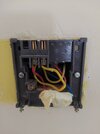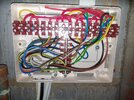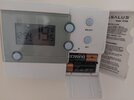I bought a Meross MTS200 smart thermostat to control our gas boiler for the central heating. I then realised that the existing thermostat (Salus RT500) is on low voltage, despite the 3 thick wire feeding it (See picture). I would like to replace it by the smart thermostat Meross MTS 200 that requires line voltage (230V), without having to bring a new wire to the thermostat, which will be a major piece of work (cost, dig in solid wall, repaint, etc...). I wondered if there was something that could be done at the boiler terminal point, to convert the line to line voltage, since main line voltage feeds it the terminal (see picture attached). Thank you for anyone that can help.
You are using an out of date browser. It may not display this or other websites correctly.
You should upgrade or use an alternative browser.
You should upgrade or use an alternative browser.
Replace Low voltage Thermostat (Salus RT500) but line voltage smart thermostat (Meross MTS200)
- Thread starter Banjara
- Start date
Sponsored Links
But 230vac IS Low Voltage!How do you conclude that the Salus is low voltage? Just looked in the instructions and appears to be 230vac.
And If I were a betting man, I would guess that the wiring centrein the picture is powered by mains voltage....
Isn't the Salus RT500 battery operated in which case it will switch whatever voltage is required?
Why do the instructions quote such things like this giving manufacturers' instructions a bad name?

Why do the instructions quote such things like this giving manufacturers' instructions a bad name?
Sponsored Links
@winston1 would have jumped on that so quickly, together with the old Cooke&Lewis instruction sheet to prove his point, again again....Isn't the Salus RT500 battery operated in which case it will switch whatever voltage is required?
Why do the instructions quote such things like this giving manufacturers' instructions a bad name?
View attachment 316555
- Joined
- 27 Jan 2008
- Messages
- 23,687
- Reaction score
- 2,669
- Location
- Llanfair Caereinion, Nr Welshpool
- Country

We have three voltages which may be found in domestic DC and AC limits are diffrent but AC under 1000 volts is low voltage so 230 volt is low voltage, and 110 volt either 55-0-55 or 63-0-63 is reduced low voltage and under 50 volt is extra low voltage in all countries members of Internation Standards Organistion ISO which it seem USA does not belong to, so they use diffrent values.
The boilers in the main have three voltages, ELV at around 24 volt, and a varying voltage 0-60 volt also ELV as DC and LV at 230 volt and many have all three options.
Thermostats can be volt free so don't care if ELV or LV or LV only or variable voltage most common is OpenTherm.
Where we have the problem is when a common cradle is used for 1, 2, and 3 channel. With 1 you can have volt free, but 2 and 3 has to be LV, although Wiser has an add on module for opentherm.
We in general want all with boiler either battery or fed from boiler, using USB sounds good until one gets a power cut and the UPS will run boiler but not the thermostat.
I have a useless Nest Gen 3 smart thermostat, it will connect to phone 200 miles away, but not the TRV's which are in the same house. But the thermostat does send all info and get power on two wires to heat link, which is why I got it.
Most smart thermostats are in two bits, the sensor battery operated, and base mains powered the latter at the boiler location.
Nest e is odd one out where thermostat hard wired to boiler but battery powered.
The boilers in the main have three voltages, ELV at around 24 volt, and a varying voltage 0-60 volt also ELV as DC and LV at 230 volt and many have all three options.
Thermostats can be volt free so don't care if ELV or LV or LV only or variable voltage most common is OpenTherm.
Where we have the problem is when a common cradle is used for 1, 2, and 3 channel. With 1 you can have volt free, but 2 and 3 has to be LV, although Wiser has an add on module for opentherm.
We in general want all with boiler either battery or fed from boiler, using USB sounds good until one gets a power cut and the UPS will run boiler but not the thermostat.
I have a useless Nest Gen 3 smart thermostat, it will connect to phone 200 miles away, but not the TRV's which are in the same house. But the thermostat does send all info and get power on two wires to heat link, which is why I got it.
Most smart thermostats are in two bits, the sensor battery operated, and base mains powered the latter at the boiler location.
Nest e is odd one out where thermostat hard wired to boiler but battery powered.
Ignoring the definition of "low voltage", your battery operated RT500 is switching mains voltage.
If this is the cable connected to the thermostat...

The Red wire could be live and the yellow, a switched live.
The blue wire appears to be connected to the neutral bus at the wiring centre.
However, do you have a central heating controller on your system, in addition to the thermostat?
If you have a separate controller, the red wire may not be a 'permanent' live.
For simplicity, you can set the controller so that the heating is constantly on, or you could link the controller out at the wiring centre.
If the above is true, you can try and connect...
Blue wire to N
Red wire to L
Yellow wire to NO
And add a small link wire between L and COM

and see if that works.
Alternatively, you could consider a battery operated smart thermostat, such as a Nest E, or swapping over the controller, which is what many people would do to give smart control of hot water as well.
If this is the cable connected to the thermostat...
The Red wire could be live and the yellow, a switched live.
The blue wire appears to be connected to the neutral bus at the wiring centre.
However, do you have a central heating controller on your system, in addition to the thermostat?
If you have a separate controller, the red wire may not be a 'permanent' live.
For simplicity, you can set the controller so that the heating is constantly on, or you could link the controller out at the wiring centre.
If the above is true, you can try and connect...
Blue wire to N
Red wire to L
Yellow wire to NO
And add a small link wire between L and COM
and see if that works.
Alternatively, you could consider a battery operated smart thermostat, such as a Nest E, or swapping over the controller, which is what many people would do to give smart control of hot water as well.
Thank you all to your replies and sorry for the delay of my reply - I am new to DIYnot and did not seem to have received notifications of your very useful replies. I am going try to answer the questions you all asked. The reasons I don't believe that the 230V is getting through the wires currently coming through the wall and connected to the Salus Thermostat are that I have measured the voltage with a multimeter, and I am getting pretty much nothing, which explains why my smart meter does not come on at all when connected to these same wires, and when measuring voltage from a lead coming directly from a plug, I am measuring the expected 230v+, which do turn on the new smart meter. Might not be relevant, but I have attached a picture of the Salus Thermostat, which shows batteries, and when I remove the 2x1.5V, the thermostat screen turns off... which I assume means that few Volts are getting through these wires. To answer questions asked by RandomGrinch, in addition to the thermostat, I do have a central heating controller on a wall too, allowing me to program on/off on the heating and water system, and when times come, I put it permanently on "On", and thermostat then send signal to start boiler system (or not) for the radiators. As well, I did exactly plug the wires as per your diagram. I am keen to avoid to go for a different thermostat like Nest E, as that would be an additional £100 of spending considering I already have a new thermostat... so keep to use your kind help and knowledge to get 230V through these wires. I am rather lost as I do read like you that the Salus RT500 should be fed by 230V. Thank you all for any of your further replies.
Attachments
With the new thermostat wired as above,
and with your C/H controller set to permanently on:
Carefully, with your multimeter, can you measure the voltage between the blue wire and the red wire and then between the blue wire and the yellow wire and let us know what the meter says for both?
and with your C/H controller set to permanently on:
Carefully, with your multimeter, can you measure the voltage between the blue wire and the red wire and then between the blue wire and the yellow wire and let us know what the meter says for both?
Yes, carefully measure the AC voltage on the screw terminals on the back of the thermostat - don't be tempted to measure on loose or bare wires.I assume you are asking to measure AC Voltage?
@Banjara please can I repeat above, and to clarify to you how the Salus thermostat works and to save you more worrying about the old thermostat.Might not be relevant, but I have attached a picture of the Salus Thermostat, which shows batteries, and when I remove the 2x1.5V, the thermostat screen turns off... which I assume means that few Volts are getting through these wires.
The power for the operation of the Salus thermostat is powered by the batteries. The batteries provide all of the operation of the stat including the display. It does not require ANY other voltage, mains or any other voltage to operate.
When the logic turns on, it operates a relay (basically a switch) and this closes two contacts. These are known as volt-free contacts.
This tells the boiler to turn on . Some boilers use mains voltage to start. Some use lower voltage. Your system uses mains voltage.
The instructions for the device are, I admit, misleading as the backplate connections are called Mains live and switched live, but that is not necessarily how it works in all cases!
The boiler system, the valves and your wiring is 230v mains, and your new Meross MTS 200 also requires this for its power and operation.
I hope this helps.
@Taylortwocities, thank you for your message - Ok, I understand that the Salus Th. doesn't need 230V to operate, but now my hope, is that following @RandomGrinch 's comment, If my programmer is on, those wire carry 230V (like the rest of the system), and therefore allowing me to just install the Merros and by turning on the C/H controller, the smart thermostat working. You are saying that Salus is battery operated, but when plugged in to the wall, and taking battery off, it still works! I thought the batteries were just here to not lose the temperature program set when removed from the backplate. I'll carry out the measures suggested by RandomGrinch and report the findings  . Thank you
. Thank you
No. I am saying that if you leave the batteries in. Remove the Salus from the wallplate, the thermostat display will still work and, if you turn up the temperature you will hear a click as the internal relay switch on. It wont switch anything because it will not be on the wall plate.You are saying that Salus is battery operated, but when plugged in to the wall, and taking battery off, it still works
No, no!!!. The batteries are there to operate the device. It has nothing to do with being on the wall plate or the boiler wires.I thought the batteries were just here to not lose the temperature program set when removed from the backplate.
If you can't grasp this then you are going to have problems with your next step....
Also with your meter use, don't forget if both wires you are measuring are at 230V (Salus switched on) your meter will read 0V
DIYnot Local
Staff member
If you need to find a tradesperson to get your job done, please try our local search below, or if you are doing it yourself you can find suppliers local to you.
Select the supplier or trade you require, enter your location to begin your search.
Please select a service and enter a location to continue...
Are you a trade or supplier? You can create your listing free at DIYnot Local
Sponsored Links
Similar threads
- Replies
- 2
- Views
- 3K
- Replies
- 3
- Views
- 302
- Replies
- 7
- Views
- 789




